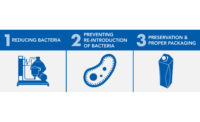The verdict on sugar consumption is in – we are guilty of over-consumption and we need to curb our desire to satisfy our sweet tooth. The newest edition of the Dietary Guidelines for Americans (2015-2020) issued in January by the U.S. Department of Health and Human Services and the U.S. Department of Agriculture contains the specific recommendation that consumers “reduce added sugar consumption to less than 10% of calories per day.”
There is an increasing belief among health professionals that added sugar consumption has contributed to the obesity epidemic and that it is associated with health complications like type 2 diabetes and cardiovascular disease. According to the Centers for Disease Control and Prevention, about 29.1 million Americans (1 in 11 people) have diabetes, another 86 million Americans (1 in 3) have prediabetes, 735 million Americans suffer a heart attack annually and 610 million Americans die from heart disease each year.
The Sugar Association stated it was “disappointed that despite a lack of scientific evidence, the Dietary Guidelines for Americans recommend an intake limit or target for ‘added sugars’ . . .” Major news outlets, however, led with headlines like “New dietary guidelines urge less sugar for all” and “New dietary guidelines crack down on sugar.”
Regardless of what is correct, consumers heard a resounding message that they should alter their eating habits to reduce added-sugar consumption. New nutritional labeling requirements will likely highlight “added sugar,” distinct from total sugar or carbohydrate. For a 2,000-calorie daily diet, the guidelines mean a limit of 200 calories from added sugars. Since 1 gram of sugar contributes 4 calories, the requirement translates to a 50-gram-limit, approximately 12 teaspoons of added sugar a day. For some consumers, this means as much as a 50% reduction in their daily total added-sugar intake.
Implications for dairy processors
Beverages (not including 100% fruit juice, milk and other dairy beverages) and snacks and sweets account for 47% and 31% of all added sugars, respectively. It really should not be a big surprise when you realize one 500-milliliter bottle of Coke has 55 grams of sugar and one package (57 grams) of my favorite Oreos contains 23 grams of sugar. In contrast, dairy foods contribute a measly 4% of total added sugar in the U.S. diet. (Ice cream is in the snacks and sweets category, not in dairy foods.)
Does that mean cultured products manufacturers can go about business as usual? I don’t think so! While many of our cultured dairy foods are unsweetened, some flavored yogurts contain approximately 25 grams of added sugar in a 1-cup-serving.
More importantly, increased consumer awareness of added sugar will create opportunities for lower or no-sugar-added cultured milk products marketing. Nutrient content claims of “no-sugar-added,” “low-sugar” or “reduced-sugar” sell products. In fact, national yogurt manufacturers have already committed to sugar reduction. For example, The Dannon Co. announced in 2014 that it would be reducing sugar in all its products by 2016.
Tools for sugar reduction
The attention given to added sugars will not change the basic preference of the majority of consumers for sweetness. When it comes to yogurt, there is an expectation that they must have a sweet taste profile to be acceptable (except for plain, unflavored varieties).
Fortunately, there are many available low-calorie, high-intensity sweeteners. For example, aspartame, acelsufame potassium, neotame, and sucralose have little or no impact on total calories and added-sugar content. Still, some consumers have questions about the safety of these sweeteners, despite the fact that many of these ingredients have undergone rigorous safety testing and have permitted usage levels that are well below safe-usage levels.
Polyols (sugar alcohols like sorbitol, xylitol, and maltitol) also provide sweetness with fewer calories. Plant-based extracts (stevia plant and monk fruit extracts) offer high-intensity sweetness and have a “natural” image.
These alternatives are not without limitations. Some can contribute undesirable aftertaste or they are not sufficiently stable in high heat or more acid environments (aspartame). They can cause gastrointestinal distress if overconsumed (polyols), or adversely impact other sensory properties of the food.
Lactose hydrolysis
One other approach (without adding sugar) is to maximize the sweetness of the naturally occurring sugar in milk. This can be achieved by hydrolyzing the milk sugar (lactose) to glucose and galactose. While this adds another step to manufacturing, the hydrolyzed lactose will be four times sweeter than the original lactose. And you can claim your dairy food is lactose-free. (That is not necessarily required for lactose-intolerant yogurt consumers, but they still look for such claims). Additionally, simultaneous hydrolysis during culturing reduces yogurt fermentation times up to 19%.
Yogurt and other cultured milks are nutrient-dense foods. So does taking some sugar out really make sense for your product line? Before you cut the sugar from all your products, be sure you know what your consumers really want, and equally important, what they do not want.





